What is the 2 out 3 in motion offense
The 2 out 3 in motion offense is a basketball offensive strategy that emphasizes ball movement, post split action, and continuity patterns to create scoring opportunities near the basket or from the perimeter.
In terms of its naming convention, to my understanding, it is referred to as a 2 out 3 in because there are two players on the outside of the free throw line extended area and three players on the inside of the free throw line extended area.
It should also be noted that this particular naming convention is much different from other numbered motion offenses. For example, the 4 out 1 in motion offense essentially means that four players will stay on the outside of the three-point arc while one player will remain inside of the arc, typically near the low post.
Similarly, the 5 out motion offense features five players that fill the five primary perimeter spots behind the three point arc, which are the top, the two wings, and the two corners.
What is an example of the initial formation for the 2 out 3 in motion offense
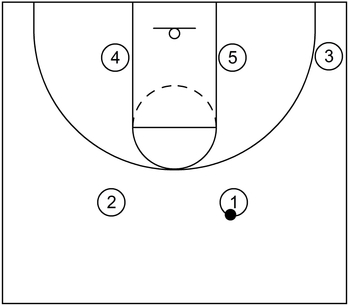
This is an example of the initial formation for the 2 out 3 in motion offense. 1 and 2 start at the top near the slots, 4 and 5 start near the low post blocks, and 3 starts in the corner behind the three-point arc.
Affiliate Disclosure: I may earn a commission on qualifying purchases made through the links below.
What are basic actions of the 2 out 3 in motion offense
Part 1 – Baseline Cut
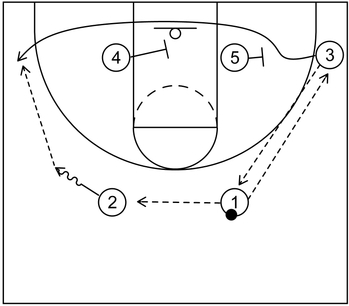
This example and the ones that follow are derived from How to Run the 2-Out 3-In Motion Offense by Steve Alford.
To start, 3 receives the ball from 1 and immediately following that, 1 receives the ball from 3. The purpose of this passing action is to simply move the defense.
Next, 2 receives the ball from 1 and as that occurs, 3 executes a baseline cut to the left side wing via screens set by 4 and 5.
From that point, 2 could dribble towards the extended slot area for a better passing angle. Afterwards, 3 receives the ball from 2 and then 3 could take the three-point shot if open.
Part 2 – Cross Screen
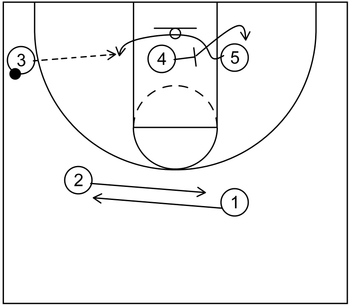
Next, if 3 did not take the jump shot, then 5 cuts to the left side low post block via the cross screen set by 4. Following that, 5 receives the basketball from 3 and could score via a low post move.
Also, as that action occurs, 4 cuts to the right side low post block while 1 and 2 exchange slot positions to occupy the defense above the free throw line extended area.
Part 3 – Post Split
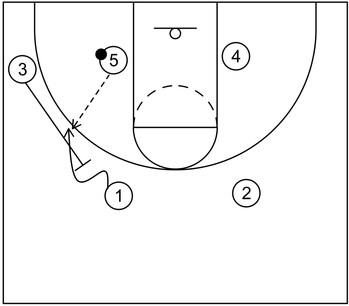
After 5 receives the ball from 3, this initiates the post split action. Therefore, 3 executes a split cut away from the low post to set a flare screen.
Next, 1 cuts to the left side wing via that flare screen and could receive the ball if 5 does not attempt to score with a low post move. From that point, 1 could take the jump shot if that is open.
Part 4 – Baseline Cut Continuity
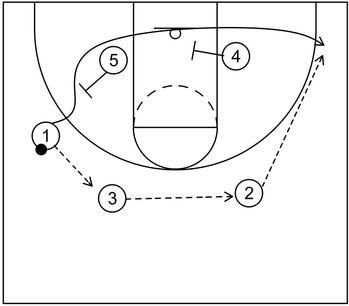
At this point, if none of the previous scoring options were available, then this begins the continuity phase of the offense.
To start, 3 receives the ball from 1 and afterwards, 1 executes a baseline cut to the right side corner by way of screens set by 4 and 5.
As that occurs, 2 receives the ball from 3 and then 1 receives the ball from 2. Following that, 1 could take the corner three-point shot if that is open.
Part 5 – Cross Screen Continuity
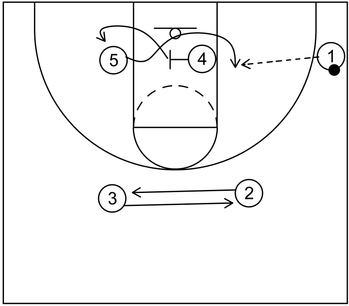
Next, if 1 did not take the three-point jump shot, then 5 cuts to the right side low post block via the cross screen set by 4. After that, 5 receives the ball from 1 and then 5 could score via a low post move.
Additionally, as that action happens, 4 cuts to the left side low post block while 2 and 3 exchange slot positions to occupy the defense.
Part 6 – Post Split Continuity
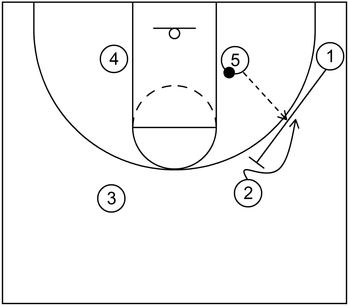
Following the post entry pass, 2 cuts to the right side wing area via the post split flare screen set by 1. If 5 does not attempt to score with a low post move, then 2 could receive the ball from 5 and then take the jump shot if open.
From there, if 2 receives the ball but does not take the jump shot, then the continuity could get initiated once again with a pass back to 1 and so on.